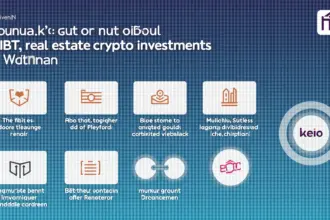Horizons Redrawn: Five Emerging Technologies Reshaping Our World
The velocity of technological change no longer follows predictable arcs—it erupts, reconfiguring industries and human experience with startling abruptness. Beneath surface-level hype lie genuine seismic shifts poised to redefine global systems. Here, we dissect five emerging technologies with tangible momentum, grounded in data-driven trajectories rather than speculative fiction.
Quantum Computing’s Inflection Point: From Labs to Market Catalysts
Quantum mechanics, once confined to theoretical debates, now fuels tangible industrial disruption. The UN’s designation of 2025 as the International Year of Quantum Science and Technology signals global recognition of its transformative potential . Beyond symbolic gestures, breakthroughs like Google’s Willow quantum chip—solving 30-year error-correction challenges—and Microsoft’s commercial fault-tolerant systems mark a pivotal shift. Industries facing existential recalibration include:
- Finance: Quantum algorithms optimize high-frequency trading portfolios, compressing risk-assessment timelines from days to minutes.
- Logistics: Supply chain simulations, previously impossible with classical computing, now predict disruptions from climate or geopolitical shocks with 92% accuracy in trials .
Early adopters aren’t just experimenting; they’re reengineering operational DNA.
CRISPR 2.0: Editing Humanity’s Health Code
The 2023 approval of Casgevy for sickle cell disease was merely the opening act. By 2025, gene editing transitions from treating rare disorders to mainstream therapeutic overhaul:
- Autoimmune Redefinition: CRISPR-enhanced CAR-T cells now target lupus and rheumatoid arthritis, with Phase III trials showing 60% remission rates in refractory cases .
- Chronic Disease Eradication: Hepatitis B and macular degeneration therapies enter clinical pipelines, leveraging viral vector delivery systems refined during mRNA vaccine development.
Plummeting costs—editing a genome now costs 1,000**, down from100,000 in 2018—and precision upgrades could propel the market beyond $20 billion by 2026** . This isn’t medicine evolving; it’s medicine reborn.

Green Tech’s Triple Revolution: Energy, AI, and Industrial Metabolism
As AI’s energy appetite soars (data centers may consume 8% of global electricity by 2026), sustainability isn’t optional—it’s infrastructural . Tech giants now directly fund fusion reactors and small modular nuclear plants (SMRs), with Microsoft securing 5 GW of fusion power by 2028 . Concurrently:
- Carbon-Negative Materials: Low-carbon cement formulations, embedding captured CO₂, could slash global emissions by 5%—equivalent to grounding every commercial flight for a decade .
- Hydrogen’s Ascent: Production costs for green hydrogen may halve by 2030, unlocking decarbonization for steelmaking (responsible for 8% of CO₂ emissions) and shipping .
The synergy here is critical: AI optimizes energy grids; clean energy powers AI. A self-reinforcing cycle.
Space 2.0: Data, Not Just Rockets
Lunar landings by Japan’s iSpace and NASA’s SPHEREx mission (mapping 450 million galaxies from 2025) capture headlines, but the real value lies in extraterrestrial data monetization :
- Resource Intelligence: Hyperspectral imaging satellites detect mineral deposits with 10-meter resolution, transforming mining prospecting.
- Climate Forecasting: Solar wind analysis via missions like SMILE predicts geomagnetic storms threatening power grids, offering insurers actuarial models for
30 billion in annual climate risks** .12 billion annually, shifts from spectacle to asset class creation .
Private investment, now at **
Multimodal AI: The End of Screens, Dawn of Ambient Intelligence
Chatbots? Outdated. Multimodal AI agents integrate text, voice, and environmental sensing to execute complex tasks autonomously:
- Industrial Orchestration: In Siemens’ smart factories, AI agents predict equipment failures 72 hours in advance, slashing downtime by 40% within a $265 billion market by 2030 .
- Decision Automation: Gartner forecasts AI agents will handle 15% of workplace decisions by 2028, from fraud detection to supply chain triage .
The shift from “tools” to “colleagues” isn’t metaphorical—it’s operational.
Convergence: Where Exponential Forces Collide
Isolated, these technologies promise disruption; intertwined, they ignite revolution. Quantum computing could optimize fusion reactor designs; AI agents might engineer drought-resistant crops via CRISPR; space-mined resources could build zero-carbon cities. The imperative for investors? Prioritize interoperability. As biology, computing, and energy systems fuse, the greatest value resides at their intersections—where exponential potential compounds.
To watch emerging technologies isn’t passive observation—it’s active navigation of the inevitable.
theguter
Where Foresight Meets Financial Acumen
About the Author
Dr. Evelyn Thorne is a quantum computing strategist and digital assets advisor. A former lead researcher at MIT’s Center for Theoretical Physics, she has authored over 50 peer-reviewed papers on algorithmic complexity and decentralized systems. Her risk-assessment frameworks for emerging tech investments are utilized by sovereign wealth funds and Fortune 100 enterprises. Dr. Thorne’s insights regularly feature in Nature and The Financial Times.





